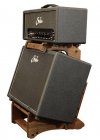22 frets
Experienced
I am in a covers band and I play mostly rhythm. Occasionally, the guys in the band let me step out and do some simple leads. I own the digital mixer and PA so I think that is why they let me play some leads.  . Anyway, I am having trouble duplicating the sounds of the original artists when playing in the higher sections of the fretboard (say from around the 10th fret up on the unwound strings.
. Anyway, I am having trouble duplicating the sounds of the original artists when playing in the higher sections of the fretboard (say from around the 10th fret up on the unwound strings.
A couple of examples are Mike Campbell’s leads on Tom Petty’s “Stop Dragging My Heart Around“ and “American Girl”. On Stop Dragging he repeatedly does a slide on the high E string up to the 12th fret between verses. He gets a full sounding note even sliding into it with lots of sustain. When I do it, it sounds thin and dies out quickly even if I try to use vibrato (which I don’t hear Campbell using on the recordings).
Same goes for the high part of the lead at the very end of American Girl. How does he get such a full sound that is comparable to the rest of the lead parts he plays in the lower parts of the fretboard. There is hardly any drop off at all.
I know some of this can be accomplished in the studio, but it seems to be the same even in live performances. I know they say it is in the fingers of the player, but can someone help me out a little here? I need the magic Fractal Secret Sauce for better high leads.
 . Anyway, I am having trouble duplicating the sounds of the original artists when playing in the higher sections of the fretboard (say from around the 10th fret up on the unwound strings.
. Anyway, I am having trouble duplicating the sounds of the original artists when playing in the higher sections of the fretboard (say from around the 10th fret up on the unwound strings.A couple of examples are Mike Campbell’s leads on Tom Petty’s “Stop Dragging My Heart Around“ and “American Girl”. On Stop Dragging he repeatedly does a slide on the high E string up to the 12th fret between verses. He gets a full sounding note even sliding into it with lots of sustain. When I do it, it sounds thin and dies out quickly even if I try to use vibrato (which I don’t hear Campbell using on the recordings).
Same goes for the high part of the lead at the very end of American Girl. How does he get such a full sound that is comparable to the rest of the lead parts he plays in the lower parts of the fretboard. There is hardly any drop off at all.
I know some of this can be accomplished in the studio, but it seems to be the same even in live performances. I know they say it is in the fingers of the player, but can someone help me out a little here? I need the magic Fractal Secret Sauce for better high leads.



